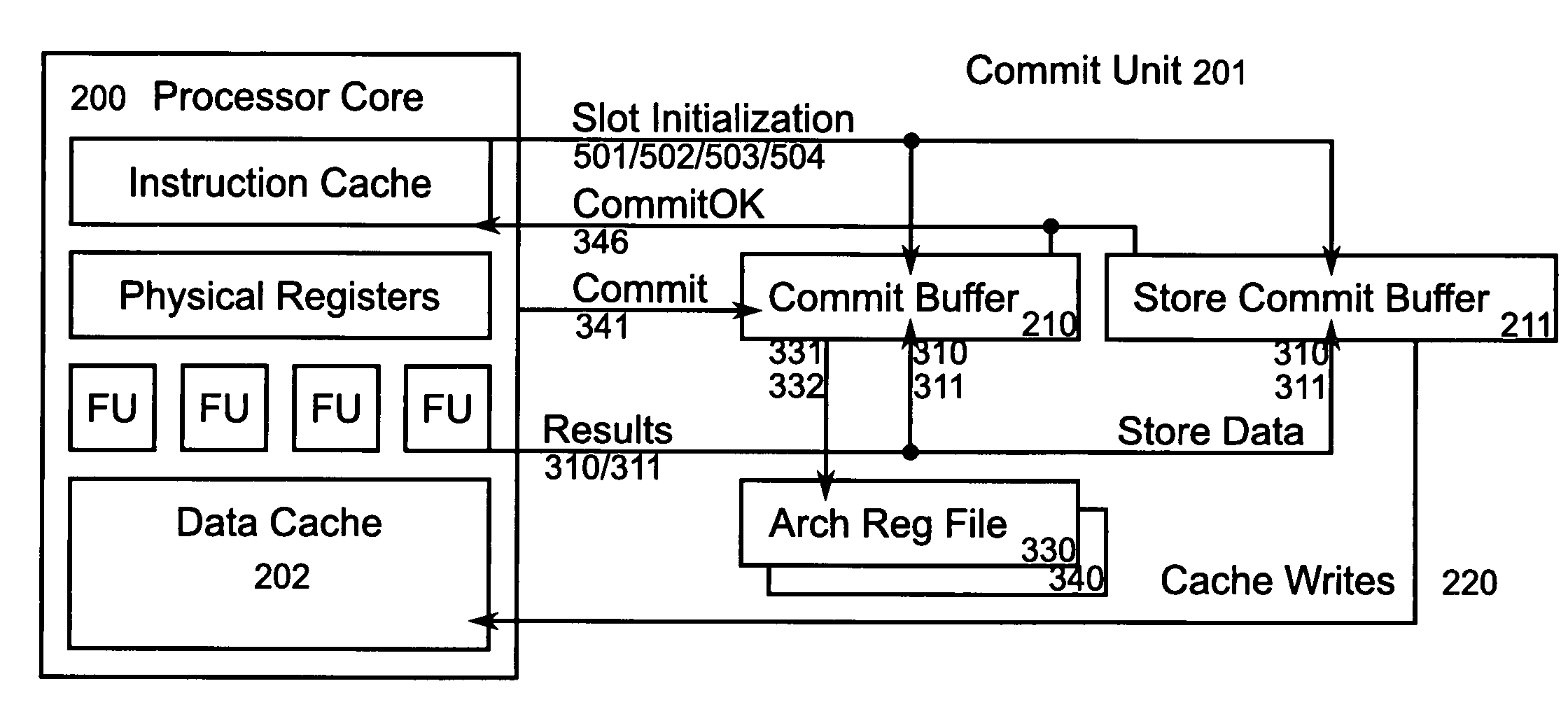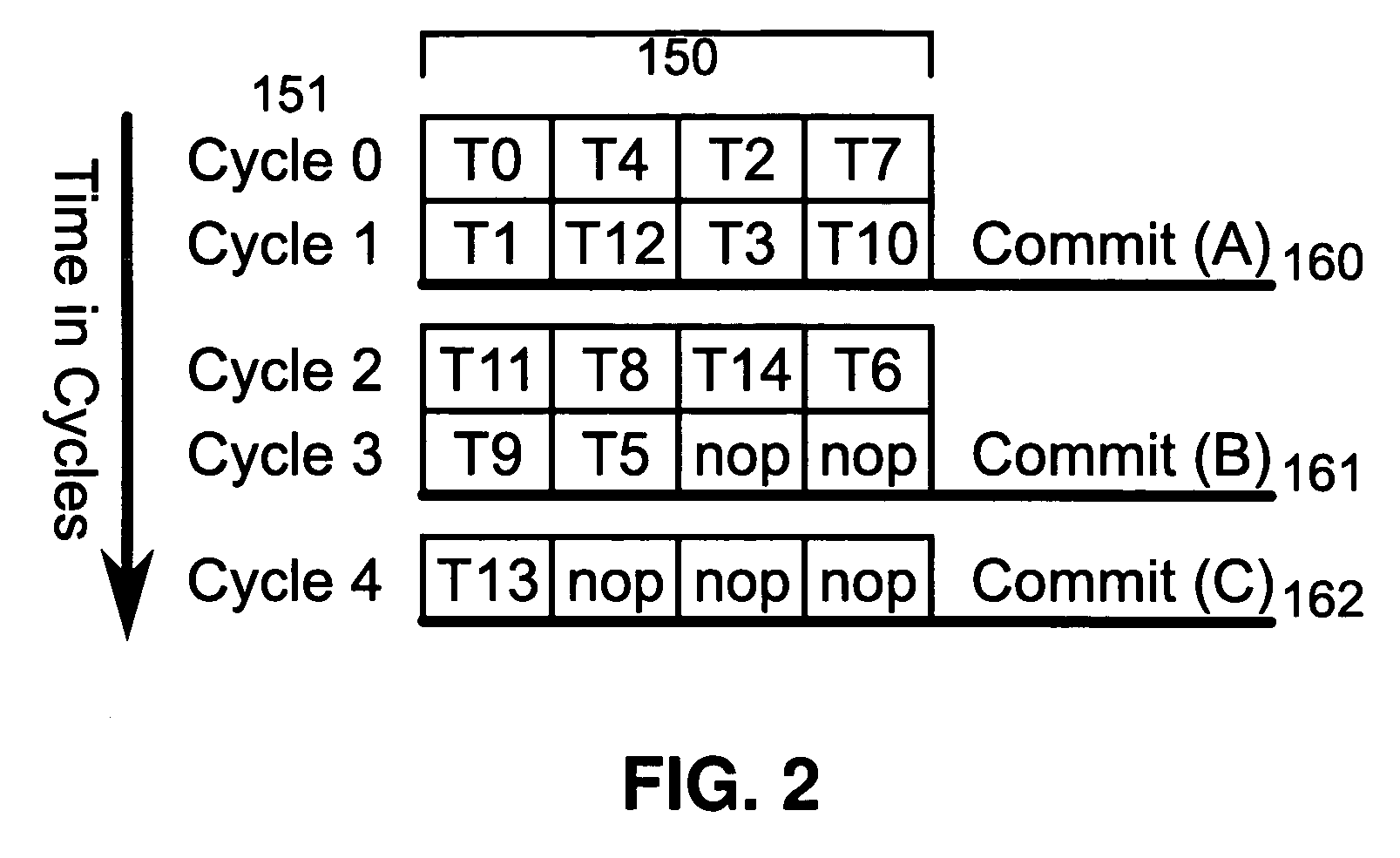Method and apparatus for incremental commitment to architectural state in a microprocessor
a microprocessor and incremental commitment technology, applied in the field of computer microprocessors, can solve the problems of substantial waste of otherwise correct computations, low efficiency of incremental commitment, and low level of instruction level parallelism of short traces, so as to improve the performance of a trace based microprocessor and reduce the overhead of rollbacks. , the effect of reducing the overhead of rollbacks
- Summary
- Abstract
- Description
- Claims
- Application Information
AI Technical Summary
Benefits of technology
Problems solved by technology
Method used
Image
Examples
first embodiment
[0044] Because operations may be scheduled outside their home commit group and such operations may generate exceptions, a mechanism is required for detecting which commit groups contain invalid results. In a first embodiment, a plurality of bits, one per commit group, may be maintained. If any operation in a given commit group G causes an exception, the bit corresponding to group G is set. If and when group G becomes the currently executing commit group, the trace is aborted and the architectural state as of the previous commit point is retained as the last known good state. In an alternative embodiment, a field indicating the first commit group in program order to encounter an exception is maintained. If the currently executing commit group matches the said field, the architectural state is rolled back as described.
[0045] Asynchronous interrupts (for instance, timer interrupts, external device events, et cetera) may occur during the execution of a trace, however such interrupts gen...
second embodiment
[0053] In a second embodiment, the commit buffer can be divided into multiple regions, such that all slots allocated to a given group occupy a contiguous range of slots within the commit buffer. This configuration is illustrated in FIG. 8B, where commit groups 511, 512 are arranged in adjacent regions at the start of the commit buffer. The commit unit can use the starting slot index and ending slot index for the region allocated to the currently executing group to select results to commit, in lieu of broadcasting the group identifier for associative matching. For example, all slots belonging to group 0 may be allocated to commit buffer slots 0-9, all slots belonging to group 1 may be allocated to commit buffer slots 10-15, and so on. The span of slots assigned to each group need not be contiguous; for instance, a plurality of regions may be specified to help reduce fragmentation when allocating commit buffer slots to each group. In the most extreme case, information indicating all c...
third embodiment
[0054] In a third embodiment, a fixed number of commit buffer slots may be reserved for each commit group in the trace; for instance, in a processor with N architectural registers, N slots may be reserved for each commit group, even if some groups do not require all N slots. In this embodiment, the index of the commit buffer slot corresponding to a given architectural register R written within group G can be obtained through a hash function of R and G. The selection of commit buffer slots belonging to a specific group then becomes trivial. Other functions for fixed slot assignments are also possible.
[0055] In either of the above embodiments of the commit slot selection mechanism, the architectural register index driven onto the bus 324 is used to drive a write address select port 331 on a register file 330 storing the speculative architectural registers. Simultaneously, the value driven onto the bus 325 is used to drive a write data input port 332 on the same register file 330. Afte...
PUM
 Login to View More
Login to View More Abstract
Description
Claims
Application Information
 Login to View More
Login to View More - R&D
- Intellectual Property
- Life Sciences
- Materials
- Tech Scout
- Unparalleled Data Quality
- Higher Quality Content
- 60% Fewer Hallucinations
Browse by: Latest US Patents, China's latest patents, Technical Efficacy Thesaurus, Application Domain, Technology Topic, Popular Technical Reports.
© 2025 PatSnap. All rights reserved.Legal|Privacy policy|Modern Slavery Act Transparency Statement|Sitemap|About US| Contact US: help@patsnap.com



